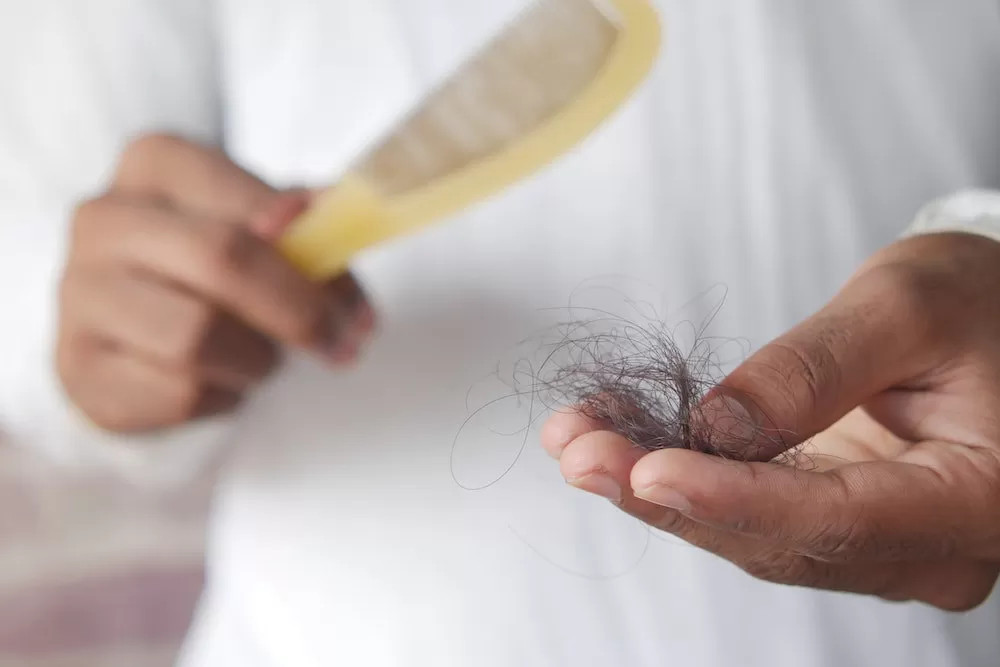In the animal kingdom, it is common to see that little animals lose part of their fur throughout the year, because their skin is preparing to withstand high temperatures such as the cold winter, so their hair regenerates and sheds especially at the beginning of spring and autumn. Human beings are mammals and we share some characteristics with other species and we also experience more hair loss in both seasons… but is it the only reason why we lose hair?
Today we will tell you what seasonal alopecia is, its causes, signs of appearance, when you should worry and the possible treatments to strengthen your hair. Let’s get started!
Tabla de Contenidos
What is seasonal alopecia?
Also known as temporary seasonal alopecia, it is a condition in which the hair enters a phase of acute loss. It sometimes causes concern to people who suffer from it, while other times it is hardly noticeable, since it is a normal process that we have all experienced.
As we have mentioned before, every day we lose between 100 and 150 hairs as part of their regeneration cycle, however, in some seasons of the year more hair falls out due to different factors. Hair loss in humans is not as marked as in animals, although it usually increases during the summer and autumn as a result of sun exposure, bathing in the sea or swimming pool water.
However, this seasonal hair loss also refers to situations or periods in which we notice greater than normal hair loss, for example after childbirth, during exam season, when caring for a sick loved one, and even as a consequence of some thyroid diseases.
Once the personal situation is resolved, the most normal thing is that the fall also normalizes. But, if after a few weeks of having returned to normal your hair continues to fall out excessively, it is time to visit a specialist.
How long does seasonal hair loss last?
The duration depends largely on the cause. For example, when transient seasonal alopecia is due to hormonal changes that a woman experiences during childbirth, the fall can last up to five months. For its part, hair loss due to a thyroid condition or menopause is solved by receiving the treatment indicated for this condition.
In some cases, the fall persists for two or three months, while in others it only lasts a couple of weeks until the stressor or nutritional factor is resolved.
What are the causes of seasonal alopecia?
- Stress episodes
- Anemia or iron deficiency
- Vitamin deficiency
- Bad nutrition
- Have had a recent delivery
- Menopause
- Hormonal changes
- Thyroid disorders
- Excess sun exposure during vacations
- Hair replacement or regeneration period
How does the hair cycle work?
To better understand what causes seasonal alopecia, it is important to know the hair cycle:
- Anagen phase. Also called growth, it is a stage that lasts more than three years and in which the length depends on genetic factors. Unfortunately, hair at this stage is very sensitive to chemotherapy and therefore loss is usually very fast during cancer treatment.
- Catagen phase. Also called transition, it is a stage that lasts about two weeks in which the follicles (the cells that give rise to the hair) die in a controlled manner and the hair bulb seals itself and approaches the skin´s surface. Meaning, it is the way in which the hair prepares for the next stage.
- Telogen phase. Known as rest, it lasts two to three months. In this stage, the hair falls out more than normal since the system is “asleep” and waiting for a new growth cycle.
It is important to clarify that the follicles are usually in different phases. That means 85% of the hair can be in the anagen phase, while 2% is in the catagen phase and the rest in the telogen phase. That´s the reason, we are not always aware that hair falls out more often than normal.
However, when people go through periods of stress or illness, both conditions are added to the telogen phase and, therefore, the fall is exacerbated.
Seasonal alopecia symptoms
The main sign is the increase in hair loss, which can be up to 300 hairs a day.
Differences between seasonal and androgenic alopecia
Increased hair loss, but maintaining volume and density
During the seasonal fall, you may notice that more hair falls out than normal, but this does not make your hair look less voluminous or dense; that is, your hair looks the same as always, but you notice that you leave more in the shower or on the pillow.
On the other hand, if in addition to the fall your hair looks thinner, with less volume and you begin to notice bald spots, it is likely that you are experiencing another type of alopecia.
When hair is in a bad shape, but it improves
Probably after a vacation period, where your hair was exposed to the sun, sea water and excesses in food, or after having gone through a preparation season for your final exams, you notice that your hair looks dull, dull or humidity, but this usually resolves as soon as you recover your normal rhythm of life, or with the use of some remedies such as masks.
However, if your hair looks dull and dry and you don’t notice an improvement even if you use hair treatments or make a change in your eating habits, we are no longer talking about seasonal alopecia, but about another type of alopecia.
Temporary hair loss
The most obvious sign of seasonal alopecia is that the hair loss stops after a while. While the androgenic alopecia persists along with the miniaturization, density loss together with the rest of the signs.
When to go to a specialist?
Seasonal alopecia due to causes such as stress, childbirth or illness are considered part of telogen effluvium, and after three or four months the lost hair will grow back.
If you are concerned about your hair loss and you notice that it does not stop, that bald spots begin to appear, that the line of your forehead is going backwards, that your hair has lost density, or that parts of your head are visible, do not self-medicate; go to a specialist in order to have an accurate diagnosis and personalized treatment.
Seasonal alopecia treatments
As its name implies, seasonal alopecia is transient, normal and usually resolves itself. However, maintaining healthy habits will help you strengthen your hair and reduce other situations that promote hair loss.
Some recommendations are:
- Maintain a healthy and balanced diet.
- Ask your doctor what vitamin supplements you can take; for example vitamin A, B, C, E, folic acid and calcium.
- Exercise to reduce stress and prevent insomnia.
- Take care of your hair when you are exposed to the sun, wear a cap, a hat, an umbrella or hair styling cream with sunscreen.
- Use hair products suitable for your hair type.
- Take care of your hair: do not pull too hard when combing it, do not abuse chemical products, nor the iron or dryer.
If alopecia left its mark on your hair, at HairFix we can help you. We are a hair transplant clinic in Mexico and with us you will find the specialist you need to strengthen your hair and make it grow through the new DHI hair implantation in Mexico technique.
Schedule your assessment appointment through our contact form. We will gladly assist you. Ask us about hair transplant in Mexico and know the best affordable hair transplant.






